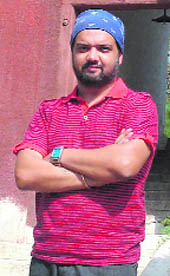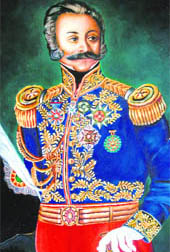Bobby Singh Bansal chose to explore a path less explored when he started working on the manuscript that became The Lion’s Firanghis: The Europeans at the Court of Lahore. The following are excerpts from an exclusive interview with Roopinder Singh:
You were born in Britain and studied there. Where did your parents migrate from?

My father originates from Punjab and my mother is from Assam.Tell us a bit about your academic background.
I studied in England, first business management, later marketing and business development. I am not a historian.
Were you interested in the academic study of history? You are a businessman, what made you take up this topic?
Of course, but I was always travelling all over the world with my business and never got the chance to professionally study Indian history at university. It’s just a chance visit to Lahore in 1989 that triggered off this passion of mine for exploring and researching further on Maharajah Ranjit Singh and his reign. The more I visited Pakistan, the more I got addicted to this topic.
Where all did your research take you, and how long did it take?

The research was quite intensive, if not exhausting. It started in London, then took me to Paris, Marseille, St Tropez, Monaco, Madrid, Barcelona, Segovia, Vienna, Rome, Bratislava, Napoli, Bologna, Berlin, Zurich, Edinburgh, Bucharest, Brasov, Lahore, Delhi, Multan, Peshawar, Algiers, Wazirabad, Texas (US) and the Khyber Pass. It took me nearly four years of research to compile material for the book. Would I do it all again? Absolutely!
I understand that you had a tough time doing your research in Pakistan.
What was your best experience, and the most hairy one?
I didn’t have a tough time in Pakistan but, on the contrary, had a lifetime experience on being told that I was probably the first Sikh since 1947 to visit the Jamrud and Shab Qadar Forts of the NWFP region that were built by General Hari Singh Nalwa. Both commanders of the forts have become close friends. I’m now whisked around in helicopters whenever I’m in Pakistan. The most hairy experience was probably encountering a Taliban at the Khyber Pass.
Who among the firangis is your favourite, and why?
There are many, I guess, but for me it’s either General Avitabile or General Allard. The first was so ferocious in implementing the laws and policies of Maharaja Ranjit Singh, especially in Peshawar and that too during the anarchy which was unleashed in Lahore in 1843, he never took sides with any factions and simply did his duty to the Lahore Durbar.

General Allard in my views probably was the Maharaja’s most loyal, if not No. 1 Firangi. I could give you endless examples, but one is that he never kept a harem and returned to Lahore after two years of leave to France, as he said he would, much to the relief of the Maharaja. The letters he wrote back home praising the Maharaja’s rule over his subjects, plus the fact that Ranjit Singh would usually consult General Allard on many important and delicate matters of the state, much to the dismay of his native courtiers. This was indeed a unique relationship, and if you read the letter you will understand why for me General Allard is a favourite.
You met various families. Which was most connected to its ancestors and thus, its heritage?
Probably, the descendant of General Allard, when I entered the lounge of his mansion in St. Tropez, it was like going back in time to Lahore. There displayed were huge oil paintings, medals and Sikh artefacts from that period displayed on the walls. He takes much pride that his ancestor served Ranjit Singh, when he poured me a cognac; he raised his glass towards to the portrait of Ranjit Singh and proudly said, “Cheers, Ranjit Singh. You are my hero”, and drank it in one go! That says it all, I guess. He still possesses countless artefacts, although in a private collection and a private archives relating to that period, I’ve never seen anything like it with any other families.
At what stage did you decide that you wanted to share it with others in the form of a book?
When a colleague of mine asked me in 2006, what I was going to do with all this research, I had no answer for him and he told me simply to write a book and share it with everybody
What’s the audience you had in mind when you were writing the book?
Students to historians, but mainly everyone, not just to the Punjabi community.
Did you have any difficulties in finding a publisher?
Not at all.
Are you planning any other book?
I could have easily written a book on each European that served Ranjit Singh. Yes, I am planning several projects, some based in Pakistan and one on Bollywood.
Please click here to read an excerpt from the book The Lion’s Firanghis: The Europeans at the Court of Lahore.
